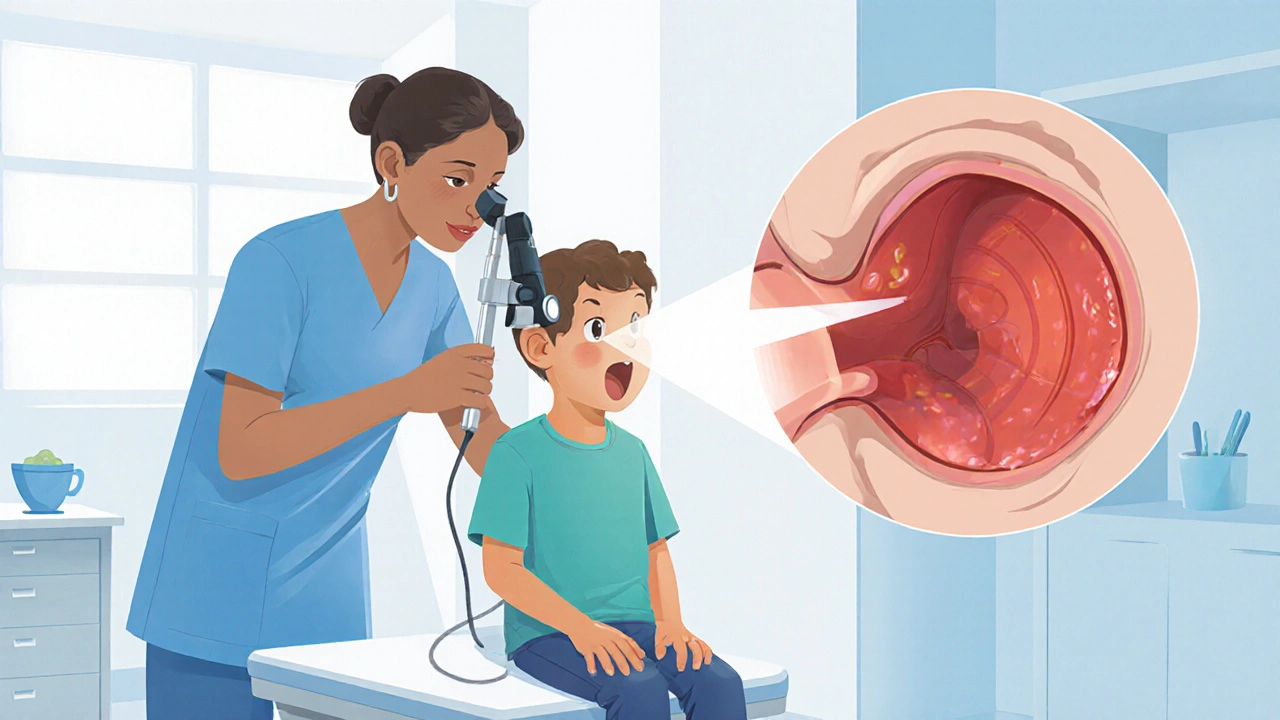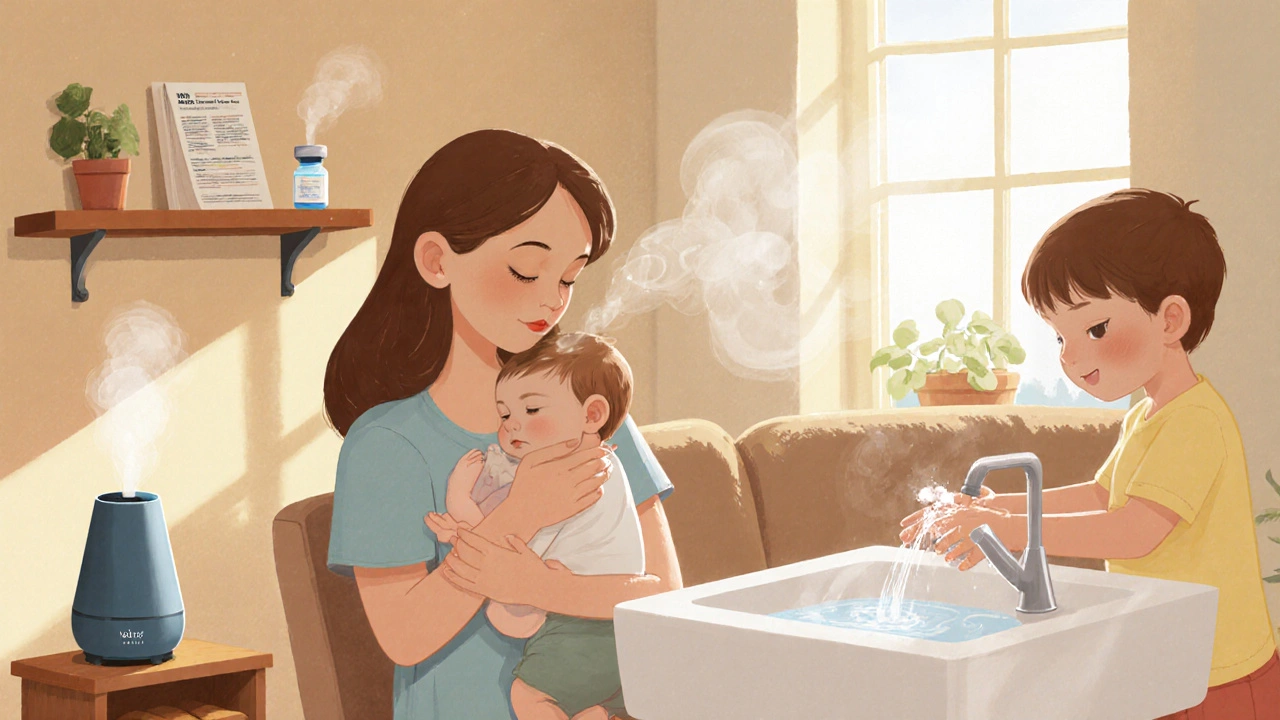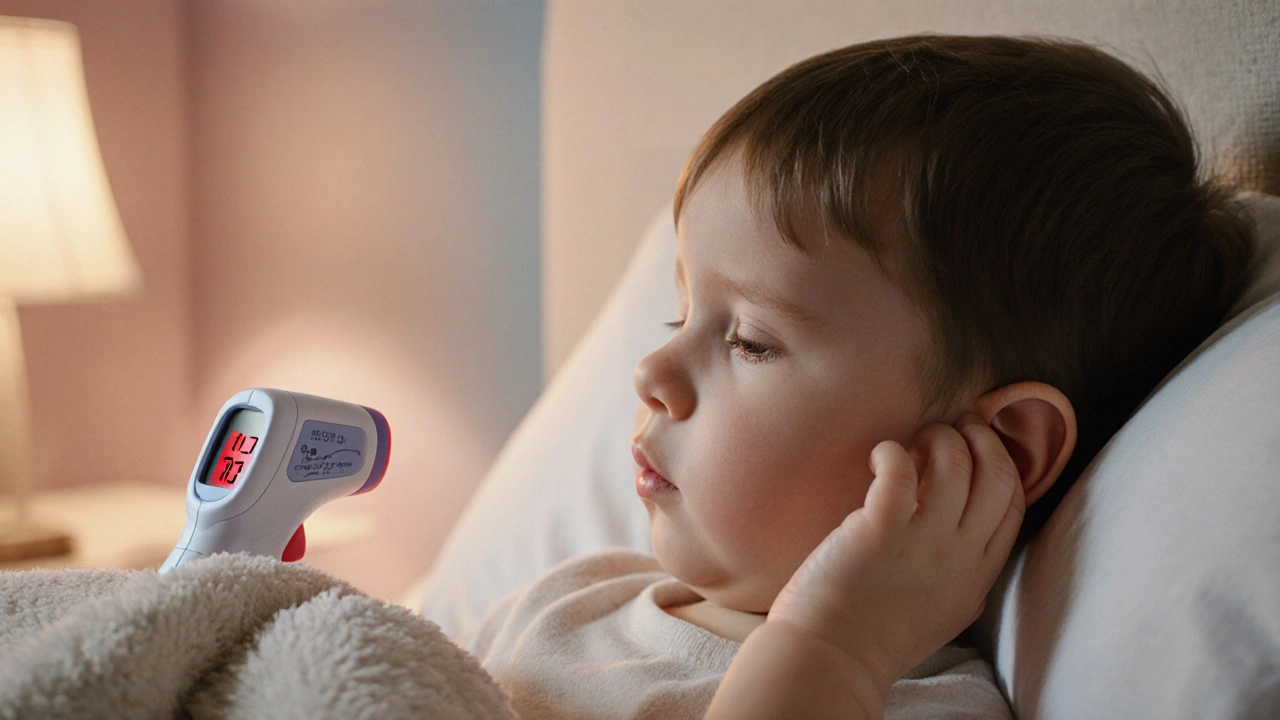Ear Infection Fever Checker
Check for Common Ear Infection Symptoms
Select the symptoms that apply to your situation:
Potential Ear Infection Assessment
Ever notice a kid’s temperature climbing and wonder if it’s just a cold? Often, a spike in temperature is more than a random fever - it can be the body’s alarm that an ear infection is brewing. Understanding the link between fever and ear infections helps you decide when simple home care is enough and when a doctor’s visit is urgent.
Why Fever Shows Up With an Ear Infection
When a fever is a rise in body temperature above the normal range, usually indicating the body is fighting an infection occurs, the immune system is releasing chemicals called pyrogens. These pyrogens reset the body’s thermostat in the brain, causing temperature to rise.
In an ear infection also known as otitis media, an inflammation of the middle ear often caused by bacteria or viruses, the middle ear fills with fluid and swells. The swelling triggers inflammation, which releases the same pyrogens that drive fever. So the fever isn’t random - it’s a side‑effect of the ear’s battle against germs.
The most common culprits are bacteria microscopic organisms like Streptococcus pneumoniae that can invade the middle ear and viruses such as the common cold virus that can inflame the eustachian tube and lead to fluid buildup. Whether the trigger is bacterial or viral, the body reacts in similar fashion - raising its temperature to create a less hospitable environment for the invader.
Key Symptoms That Pair Fever With an Ear Infection
- Fever of 100.4°F (38°C) or higher, often occurring suddenly.
- Ear pain that worsens when lying down or pulling on the earlobe.
- Fluid draining from the ear - a clear, yellow, or pus‑filled discharge.
- Difficulty hearing or a “plugged‑up” feeling in the ear.
- Irritability in infants, tugging at the ear, or reduced appetite.
When you spot two or more of these signs together, the odds that the fever stems from an ear infection jump significantly.

How Healthcare Professionals Diagnose the Connection
A pediatrician a medical doctor specializing in the health of infants, children, and adolescents will usually start with a visual exam using an otoscope - a tiny lighted magnifier that lets them see the ear drum. A bulging, red, or fluid‑filled drum confirms inflammation.
In uncertain cases, they may order a tympanometry test, which measures eardrum movement, or a hearing test for older children. Lab cultures are rare for routine ear infections but might be done if symptoms linger beyond ten days.
Treatment Options: From Home Care to Prescription
- Pain and fever relief: Give age‑appropriate doses of acetaminophen or ibuprofen. These medicines lower temperature and ease ear pain.
- Warm compress: Applying a warm (not hot) washcloth to the affected ear for 10‑15 minutes can improve circulation and lessen discomfort.
- Observation: For many children, especially those under 2 years old, doctors may recommend watching the infection for 48‑72 hours, because viral infections often clear without antibiotics.
- Antibiotics: If the infection is bacterial, persistent, or the child is very young, a antibiotic a medication that kills or stops the growth of bacteria, commonly prescribed as amoxicillin for ear infections such as amoxicillin is prescribed for 7‑10 days.
- Follow‑up: A second exam after the medication course ensures the fluid has drained and the ear drum has healed.
Never give adult antibiotics or share medication between siblings - the dosage and type matter for each age and weight.
When to Seek Immediate Medical Attention
- Fever above 104°F (40°C) that doesn’t come down with medication.
- Severe ear pain that keeps the child awake.
- Swelling or redness behind the ear.
- Balance problems, vomiting, or a stiff neck - signs that the infection may be spreading.
- Persistent fluid discharge for more than a week.
These red flags suggest complications like mastoiditis or a middle ear effusion that could affect hearing long‑term.

Preventing the Fever‑Ear Infection Cycle
Most ear infections start after an upper‑respiratory infection (a cold) because the eustachian tube - the passage that equalizes pressure in the middle ear - gets swollen and blocked. Simple habits can keep that tube clear:
- Keep vaccinations up to date - especially the pneumococcal and flu vaccines.
- Breastfeed infants for at least six months; breast milk provides antibodies that lower infection risk.
- Avoid exposing children to cigarette smoke, which irritates the airway and eustachian tube.
- Practice good hand hygiene to reduce the spread of colds and flu.
- Use a humidifier during dry winter months to keep nasal passages moist.
These steps don’t guarantee a clean slate, but they drastically reduce the odds that a simple cold will turn into a fever‑inducing ear infection.
Quick Checklist: Is Your Fever Linked to an Ear Infection?
- Is the fever 100.4°F (38°C) or higher? ✔️
- Is there ear pain, tugging, or fluid discharge? ✔️
- Did the fever appear after a cold or sinus infection? ✔️
- Is the child under 3 years old (high‑risk group)? ✔️
If you answered “yes” to most items, start with pain relief, monitor for 48‑72 hours, and contact your pediatrician if symptoms worsen or don’t improve.
| Illness | Typical Age | Fever Range (°F) | Key Ear‑Related Symptom | First‑Line Treatment |
|---|---|---|---|---|
| Otitis media (ear infection) | 6months‑3years | 100.4-103 | Ear pain, fluid discharge | Pain relievers ± antibiotics |
| Strep throat | 5‑15years | 101-104 | Rare ear pain | Antibiotics |
| Viral gastroenteritis | All ages | 100-102 | Usually none | Hydration, anti‑fever meds |
| Sinusitis | Teens‑adults | 100.4-103.5 | Referred ear pressure | Decongestants, sometimes antibiotics |
Frequently Asked Questions
Can a fever occur without an ear infection?
Yes. Fever is a general sign of any infection or inflammation, including colds, flu, urinary tract infections, and more. Ear pain and fluid discharge help pinpoint an ear infection specifically.
Do all ear infections cause fever?
Not always. Some mild viral ear infections may cause only mild discomfort without a noticeable temperature rise. However, most bacterial middle‑ear infections do produce a fever.
When is it safe to use over‑the‑counter antibiotics for ear pain?
OTC antibiotics aren’t recommended because dosage and the specific bacterial cause must be determined by a doctor. Using the wrong antibiotic can lead to resistance and may not relieve symptoms.
How long does a fever last with an ear infection?
Typically 2‑4 days if the infection is viral. Bacterial infections may keep the fever up for a week or more until antibiotics start working.
Can repeated ear infections affect hearing?
Frequent middle‑ear infections can cause fluid buildup that temporarily dampens sound transmission. In rare cases, chronic infections lead to permanent hearing loss, which is why prompt treatment and prevention matter.



13 Comments
Sandra Maurais
October 9, 2025 AT 23:40While the article does a commendable job outlining the clinical signs of otitis media, its prose suffers from a lack of precision in distinguishing viral from bacterial etiologies 😒. The checklist, though helpful, oversimplifies the decision‑making process that pediatricians employ. Moreover, the recommendation to "avoid adult antibiotics" could be expanded to discuss dosage calculations based on weight and age 🤖. A more rigorous citation of guidelines would elevate the piece from a lay‑summary to a reliable reference. Overall, the content is useful but could benefit from tighter editorial standards. 😊
Michelle Adamick
October 9, 2025 AT 23:45Great rundown! This article really nails the key fever‑ear infection link, and the use of a symptom‑checker is pure 🔥. Parents can instantly gauge risk without scrolling endless medical jargon. The preventive tips are spot‑on, especially the emphasis on vaccination and humidifiers – total game‑changers for families. Keep the vibe high, and maybe throw in a quick video demo of the warm compress technique for extra engagement! 🎉
Mike Creighton
October 9, 2025 AT 23:55Ah, the fever – that fiery sentinel of our body's hidden battles. When the eustachian tube becomes a bottleneck, the middle ear transforms into a crucible where microbes clash with our innate defenses. The rise in temperature is not merely a symptom but a deliberate strategy, a biochemical thermostat resetting to starve the invader. Yet, in our haste to quench the heat, we sometimes neglect the symphonic orchestra of inflammation that signals deeper unrest. Let us remember that each spike is a narrative, a story of cells rallying, of cytokines marching, of the delicate balance between pathogen and host. In this light, the article's emphasis on observation before prescription feels like a respectful nod to the body's own wisdom.
Desiree Young
October 9, 2025 AT 23:58this is plain wrong stop.
Vivek Koul
October 10, 2025 AT 00:05Esteemed readers, the discourse presented herein offers a comprehensive overview of otitic fever. It delineates the pathophysiological cascade with admirable clarity, noting the pyrogenic response precipitated by middle‑ear inflammation. The enumeration of clinical hallmarks – fever, otalgia, effusion – aligns with established pediatric guidelines. Furthermore, the discussion of diagnostic adjuncts such as tympanometry reflects an awareness of nuanced evaluation techniques. Preventive counsel, including immunization and avoidance of tobacco exposure, is particularly commendable. Nonetheless, a modest suggestion: integrating epidemiological data on regional bacterial resistance patterns could enrich therapeutic decision‑making. In sum, the article stands as a valuable educational resource for caregivers and clinicians alike.
Frank Reed
October 10, 2025 AT 00:07Totally agree with the points made above! just a quick heads up – if you're giving kids ibuprofen, make sure the dosage matches their weight, not just age. Also, a warm compress can be a real game changer – just dont make it too hot! gotta keep an eye on those fevers and call the doc if anything gets worse.
Lauren Carlton
October 10, 2025 AT 00:11The piece contains several grammatical oversights that undermine its credibility. For instance, the phrase "a antibiotic" appears twice, which is a basic article error. Additionally, inconsistent use of the serial comma disrupts readability. A thorough editorial pass would rectify these issues and improve overall quality.
Katelyn Johnson
October 10, 2025 AT 00:17I love how the article blends practical tips with scientific detail – it really helps parents feel empowered. The checklist is super handy and the prevention section is a nice touch. Keep up the good work!
Elaine Curry
October 10, 2025 AT 00:19Hey, nice article but you should add more about home remedies – like using garlic oil drops. Also, a quick reminder: if the child seems extra sleepy, that's a red flag.
Patrick Fortunato
October 10, 2025 AT 00:27Honestly, this is just another piece of American health propaganda. They never mention the traditional remedies used back home in Ireland that actually work. If you want real solutions, look beyond the mainstream.
Manisha Deb Roy
October 10, 2025 AT 00:32Very informative. The article correctly highlights when to seek medical care and provides clear guidance on pain management. It’s concise yet thorough, making it a solid reference.
Helen Crowe
October 10, 2025 AT 00:35Great job! The use of clear, actionable steps and the emphasis on vaccination really resonates. Adding a quick infographic could make the key points even more digestible. Keep spreading the word! 🚀
Anthony Aspeitia-Orozco
October 10, 2025 AT 00:52The phenomenon of fever intertwined with otitis media invites us to contemplate the delicate choreography of the human immune response. When a pathogen infiltrates the middle ear, the local inflammatory milieu erupts, releasing pyrogenic cytokines that traverse the bloodstream to recalibrate the hypothalamic set‑point. This thermoregulatory shift is not a mere side effect but a strategic maneuver, elevating temperature to impede microbial replication. In parallel, the eustachian tube's obstruction amplifies pressure differentials, fostering fluid accumulation that serves as both a breeding ground for bacteria and a catalyst for further inflammatory signaling. The child's fever, therefore, is an embodiment of the body's systemic alarm, echoing the localized turmoil within the auditory canal.
From a clinical perspective, the article adeptly enumerates cardinal signs – abrupt fever exceeding 100.4°F, otalgia intensified by positional changes, and otorrhea – that together constitute a diagnostic triad. Yet, the granularity of pathogen differentiation warrants deeper exploration; distinguishing viral from bacterial etiologies influences the therapeutic armamentarium, particularly the judicious use of amoxicillin. Moreover, the recommendation of a 48‑ to 72‑hour observation window aligns with contemporary guidelines that advocate watchful waiting in select pediatric cohorts, acknowledging the self‑limiting nature of many viral infections.
Preventive strategies articulated in the piece resonate with public health principles. Immunizations, especially pneumococcal conjugate and influenza vaccines, have demonstrable efficacy in reducing the incidence of otitis media. Equally, modulating environmental exposures – cessation of household tobacco smoke and maintenance of optimal humidity – mitigates mucosal edema and preserves eustachian tube patency. These interventions underscore a proactive stance that transcends reactive treatment, fostering resilience against the fever‑infection cascade.
In the broader philosophical tableau, fever can be viewed as a sacrificial flame, a corporeal manifestation of the ancient doctrine that heat purges impurity. The child's discomfort is a poignant reminder of the vulnerability inherent in our biological systems, prompting caregivers to balance compassionate care with evidence‑based medical prudence. Ultimately, the article serves as a valuable conduit between scientific rigor and accessible health education, guiding families through the complexities of febrile ear infections with clarity and empathy.